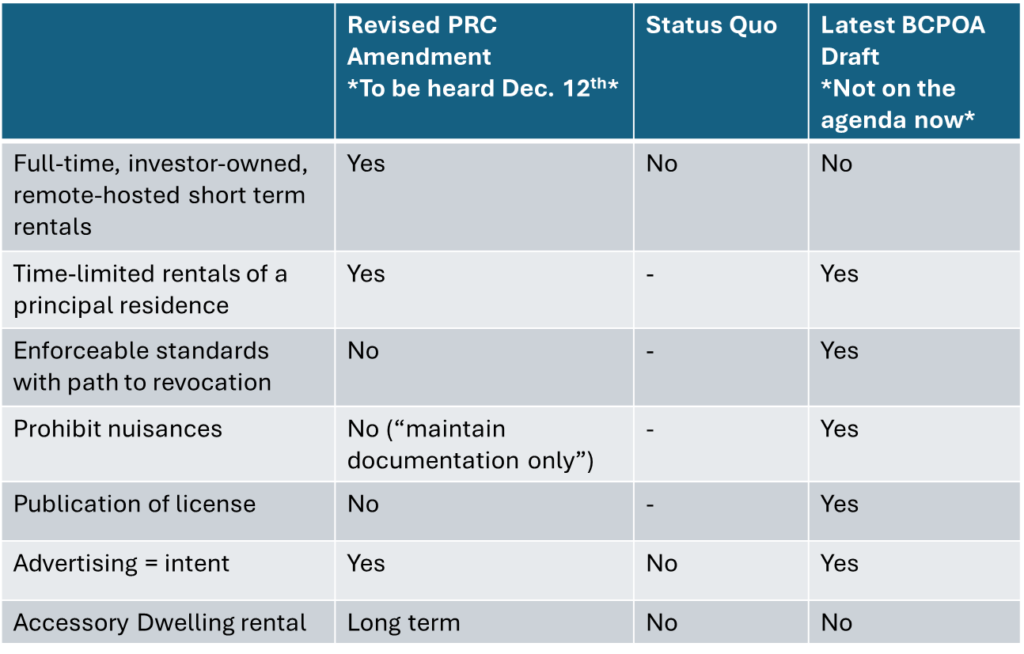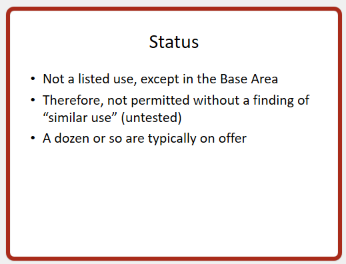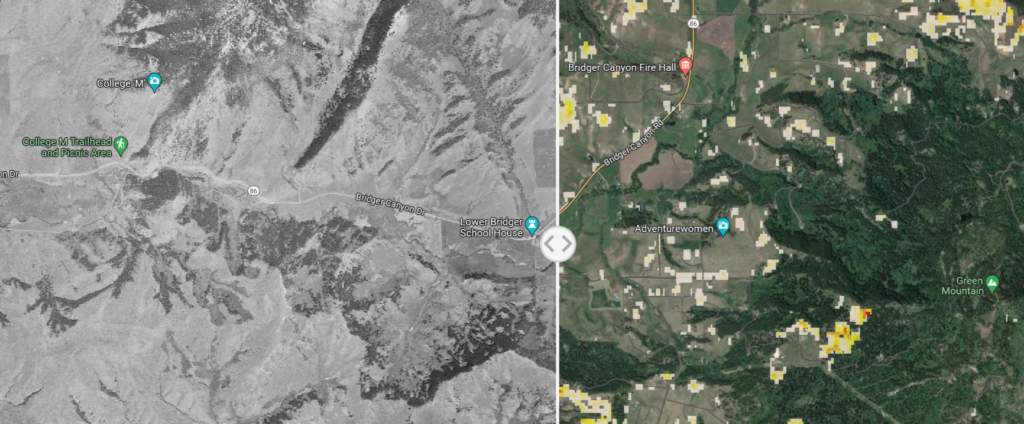The following table is a quick-reference for comparison of three options:


The Property Rights Coalition’s zoning amendment providing short term and ADU rentals will be reconsidered by the Planning and Zoning Commission in December.
The revised submission follows. If you want to save time, the cover letter describes the changes in this version on pages 3-4, and the actual text of the amendment is Exhibit A, starting on page 5. Everything after Exhibit A (page 9+) is background material.
This amendment is an update to the amendment heard in June, which BCPOA opposed. At that hearing, the commission declined to approve the amendment, but tabled it for an attempt at a compromise to be reconsidered by the end of the year.
It was not possible to reach a compromise, because the parties have some irreconcilable differences. The coalition amendment seeks full-time, remote-hosted Short-Term Rentals and long-term rental of Accessory Dwelling units, and these are two things that a majority of our membership decidedly opposes. Our legal counsel has also advised us that the language for standards of conduct is likely unenforceable. For these reasons, the BCPOA board has voted to oppose this version of the amendment as well.
Normally comment should be directed to planning@gallatin.mt.gov, but in this instance you can send your letter straight to the Director, at
With direction of the board, the BCPOA Zoning Committee created a draft standard. In October, the board didn’t have a majority supporting the standard, and sent it back to committee for further work. The primary objections were to provisions 1.d. (a grandfather or amnesty clause, felt to be unfair) and 1.b. (an “adjacent” clause, felt to create too much potential for commercialization). The October draft is here:
The committee’s latest markup is here:
The board has deferred action on this version until after the Dec. 12th Planning & Zoning hearing considers the PRC amendment.
The following is an excerpt from the 2017 Zoning Advisory Committee public meeting on Short Term Rentals. It’s an AI transcript, so a few words may be off, but the essence is correct I think.
I haven’t cross-checked who’s speaking here, but presumably some combination of Richard Lyon and Tom Fiddaman (Zoning Advisory Committee members and BCPOA directors) and Chris Scott and Randy Johnson (Planning Department staff supporting the zoning update).
But at the same time, since we do have a conditional use permit for Bed&Breakfasts, which you trouble to obtain at one time, there’s some value, I think, having a level playing field for various kinds of accommodations. So you don’t have to serve it. The bootleg layer and a license later competing with one. You’re suggesting that any short-term rentals should fall under conditional use requirement? Well, that’s one proposal. The majority of the draft, for example, is to make a conditional use permit. So that takes us to the options. So maybe I should have covered that for a quick moment at this time.
So at the moment, short-term rentals are in a legal gray area because they’re not a listed use in the canyon. And the way the zoning works is that each district designates uses that are allowed within it. You know, so you can have single family residents and agricultural operations and whatever else. And then there are maybe additional conditional uses for which you need a permit required hearing. So the matter of right uses, you can just go get a land use permit or any other permit at all. You just do it and there’s no remaining standards, but there’s certain knowing components of that. Next there is a conditional use permit. To get that, you need to meet whatever standards are set and then get a permit through a hearing. And the nice thing about that is it creates some visibility of what’s happening and gives neighbors an opportunity to comment on the permit. And the commission can impose additional conditions, you know, restrictions on hours of operation or whatever they think it takes for them to negate impacts on neighbors.
And then anything else is that’s not listed is implicitly forbidden except that maybe similar enough to an existing to a list of use that you get what’s called finding similar use and get permitted that way. So cell towers could come in by finding similar use to a microwave tower. No one has actually done that for a short term rental. So they’re not mentioned, no one to obtain a similar use finding, but it’s not good. They wouldn’t get one if they asked for it.
And to our knowledge, no one has complained about one. That’s right. I was going to follow up with that. I made sure to ask our code enforcers as well. Whether or not we’ve even received a complaint of a short term rent. Yeah, Nicole Olmsted of code enforcement, we haven’t. Other than one that was it was a tourist license that was through environmental health. And I think it was a matter of getting them to get that, but nothing related to zoning. Right. Yeah. So there’s in if you read through the comments that I compiled, there’s a little bit grumbling about things that have happened. But no one has actually filed a zoning complaint over short term rent. And there are typically a dozen or so on VRBO and Airbnb and other places.
So options. We could just be silent on this and continue to ignore it until it’s an easier issue. We felt like that was kind of an abrogation of our responsibilities as the advisory board. We have a session for everyone around the other. So the legal limbo doesn’t continue. We could allow short term rentals without any additional standards or regulation. We could allow it and require a permit, which would at least create some visibility on what’s going on. And I could be either a land use permit, which you can think of going out and filling out a form or could be a additional use permit that they could hear. And consent some standards. And finally, simply, they are [banned] outright, which is what Hebgen Lake have done, except in a commercial district.


Subsequent to this meeting, the Zoning Advisory Committee drafted a fairly permissive STR standard, which became Section 15.16 of the draft General Standards by 2018. BCPOA supported the draft through the 2021 zoning update (and objected when it was not included). If you read the letter in the Chronicle claiming that “the Bridger Canyon Property Owners Association and commissioners decreed that STR rental were BANNED immediately on February 8, 2024”, rest assured that it is pure fabrication. BCPOA didn’t ban STRs, and has no legal power to “decree” anything. From the meeting notes above, and various other proceedings, STR operators were on notice of the dubious legal status long before 2024.
At the last board meeting, we reviewed the draft above, produced by the Zoning Committee. The board didn’t move the draft forward, but rather sent it back to committee for further work, and generations of alternatives. Generally the criteria in section 1, particularly 1.b. and 1.d., where regarded as too permissive. Please share your comments below, or email the board. Specific suggestions are most helpful.
One of the effects of the proposed Short Term Rental zoning amendment is to make Accessory Dwelling Units rentable short or long term.
An Accessory Dwelling Unit (ADU for short) is an additional dwelling on a parcel, with limitations on size (1200 sq ft), proximity to the main residence (150 ft), shared access and utilities, and use (it may not be rented). Details are in the zoning regulation, section 12.2.
ADUs were added in the 2020 zoning update, replacing the existing Guesthouse and Caretaker’s Residence standards.
In drafting the ADU standard, the Zoning Advisory Committee had several goals:
One might legitimately wonder whether the ADU standard succeeds in respecting the General Plan’s 1-in-40 density. Certainly the effect is to provide 2 dwelling units on one parcel. However, the Advisory Committee felt that this was reasonable given that the restrictions on use (rental) prevented most dual-occupancy scenarios, limiting the density impact. They also felt that it was as close to compliance as was feasible, given the Commission’s lack of respect for the letter of the law in Caretaker’s Residence approvals at the time. Lifting the no-rental provision would certainly change that calculus, turning the ADU into a clear violation of the density in the plans and regulations.
The 1971 zoning regulation provided for guesthouses. A guesthouse was deliberately not a complete dwelling, in keeping with the General Plan’s provision of one single family residence per 40 acres:

Enforcement of this standard was somewhat problematic, because the county’s interpretation of “kitchen” was “has an oven.” This led to enforcement problems, with bootleg ovens installed installed in de facto kitchens post-approval.
The Caretaker’s Residence appeared as an amendment some time prior to the 1999 edition of the regulation. It’s rather poorly drafted and ambiguous.
3.16 Caretaker’s Residence: Dwelling Unit for a person that takes care of the house or land of an owner who may be absent.
The definition includes a few restrictions, that the dwelling is for “a person” (singular) and, at least implicitly, that the use is for a bona fide caretaker, not some other use, like a short term rental guest.
Note also that, by calling the residence a “dwelling unit”, it is clear that it requires a density right:
Through 2005, the county took the density and use requirements seriously. Administrative decisions denied one resident a Caretaker’s Residence on 30 acres in 2001, and initially refused to entertain one on another site with 120 acres.
From about 2006, the county’s reading of the regulations loosened, to the point of absurdity. At first, Caretaker’s Residences were granted on smaller parcels, even though they lacked the required second density right. These approvals carried a “no rental” condition clarifying the concept of bona fide caretaking.
The low point for rule of law came in 2014, when the commission granted 2 Caretaker’s Residences on acreage with insufficient density rights, and Commissioner Skinner opined that “if you have a goat, you can have a caretaker.”
It’s risky to speculate about court outcomes, but appealing these decisions probably would have been like shooting fish in a barrel. BCPOA declined to do so, in the hope that the zoning update would provide a speedier resolution without conflict with the county.
BCPOA statement on Short-Term Rental/Accessory Dwelling zoning amendment for Bridger Canyon
As many of you are aware, the Gallatin County Planning and Zoning Commission will be considering the adoption of a text amendment (not submitted by BCPOA) to the Bridger Canyon Zoning Regulation to allow for short-term rentals in Bridger Canyon. The hearing for this matter is scheduled for June 13 at the Gallatin County Courthouse beginning at 8:30 am. [The amendment text and narrative are posted here.]
We have received and listened to feedback from residents in the canyon and know that there are diverse opinions regarding short term rentals in general and this zone text amendment in particular. After compilation of survey responses from BCPOA members, Bridger Canyon residents, and Bridger Canyon property owners along with much consideration, debate, legal consultation, and discussion, the Board of the Bridger Canyon Property Owners Association has elected to oppose the adoption of this amendment. We are aware that our position will reflect the input of all involved.
https://bcpoa.net/2024/05/may-2024-str-survey-preliminary-responses
[Missed the survey? Take it now here.]
At the Board level, we have kept two objectives in mind throughout the discussion of this issue. Our first objective (and really the reason for the original formation of the Board) is to look at the zoning Regulation and the General Plan and ensure that our position remains consistent with these. Our second goal is to solicit feedback from Canyon residents and property owners and attempt to arrive at a solution that works well for residents in the canyon.
With that in mind, we believe that there may be a path forward for short-term rentals in the Canyon. This process must be subject to certain standards and guardrails that protect the rural and community aspects of the Canyon, respect the concerns of our community, and address the needs of most Canyon community members. We are actively engaged in seeking such a solution. We do not believe the current zoning text amendment accomplishes this objective. Specifically, this short-term rental/accessory dwelling zoning text amendment lacks provisions to:
The Board plans to testify to this effect at the upcoming Commission meeting on June 13. However you may think about this issue, we emphatically encourage you to participate in the hearing and voice your opinion by either commenting in person or providing written testimony to the Planning and Zoning Commission at planning@gallatin.mt.gov. Submit comments by May 30, 2024 for inclusion in the Planning Departments analysis and staff report. Submit by June 12, 2024 for inclusion in the record and review by Commission on the hearing date. [More details on commenting and testifying are provided here.]
Update: the Planning Department has requested that comment be directed to the Director, at
BCPOA’s annual General Meeting of the membership sees the election of directors to represent you, and covers a variety of news from the year.
We’ll be meeting in person at the Bridger Canyon FD Community Room, 8081 Bridger Canyon Road. We hope to see you there!
Agenda
Members unable to attend the general meeting may vote by proxy; see http://bcpoa.net/about-bcpoa/bylaws/
The survey was jointly drafted by the board, with a view to inclusiveness and neutrality. There is no specific language about the proposed ZTA, and no preamble containing advocacy. We gave STRs the benefit of the doubt by asking about benefits before concerns, and gave people the opportunity to respond with unprompted text comments. The survey was distributed before the board released its statement of opposition, as it was a key part of our information gathering.
The survey was sent to BCPOA members (about half the list) as well as nonmembers on the Bridger Canyon email list, which includes entries from other organizations, signups at the BC picnic, and other ad hoc subscriptions, totaling 518 unique email addresses for canyon households. The survey was also promoted via a paper mailing to all known canyon addresses. The response rate was just under 20%. (It has since climbed slightly, without changing the qualitative outcome.) We required unique email addresses to limit the ability of a few to spam the results with multiple responses, a problem that marred an earlier attempt. No responses were suppressed in the reporting of results.
While no survey instrument is perfect, we believe that this is about as close as one could get to a broad view of canyon opinion, short of holding a formal election.
These results haven’t been fully validated for duplication etc., but spot checks suggest no obvious issues.
The Chronicle covers a new map using aerial photos to reveal long-term changes in the Montana landscape. It’s quite interesting to see how things have changed.
 You can try it out for yourself at the Montana Landscape Explorer site.
You can try it out for yourself at the Montana Landscape Explorer site.
Tip: the map is easier to work with if you use the full-screen option. If you switch to satellite view, you’ll also find that it includes Headwaters Economics’ wildfire hazard layer.
Montana NRCS cites woody encroachment as a big issue:
Montana’s productive grasslands provide habitat for incredible populations of diverse wildlife and forage for the state’s important grazing economy.
Encroaching trees like juniper and Douglas fir are threatening these services by degrading habitat and making it harder for the families who have stewarded these lands for generations.
The maps for my area date to 1948, and I can definitely see substantial expansion of the Douglas fir forest on Green Mountain. This may be part of the story behind declining mule deer populations noted in the region.
There’s potentially a big caveat: climate impact studies project a huge reversal of the woody encroachment trend. Much of the northern Rockies may revert to a sagebrush ecosystem due to changing temperature and moisture. However, if the mechanism of that forest decline is fire and pests, it won’t be a smooth ride for us.
